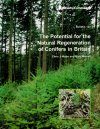![The Potential for the Natural Regeneration of Conifers in Britain The Potential for the Natural Regeneration of Conifers in Britain]()
Click to have a closer look
About this book
Customer reviews
Related titles
About this book
Language: English with trilingual summary in English, French, and German
An introductory chapter notes the historic and current use of conifer natural regeneration in Great Britain, listing the advantages and disadvantages of its use in forest management. Coning levels vary markedly from year to year, so it is often desirable to predict the onset of particularly favourable years for seed production. Early thinning helps to promote crown development, which will lead to enhanced seeding from trees in stands when they reach optimum productivity at 25–40 years of age. The majority of seed dispersed from mature trees of around 20 m in height will fall within 100 m, equivalent to the radius of a circular coupe of 3 ha.
Conifer seed rarely remains viable on the forest floor for more than one year. Germination normally occurs in spring with the onset of warm moist conditions following an overwintering period where chilling helps to break the shallow physiological dormancy. Silvicultural operations to promote rapid establishment of dense natural regeneration must be planned to coincide with years when good quantities of seed are produced. Cultivation to mix the mineral soil with the litter layers helps to provide the favourable seedbed conditions of adequate soil moisture and lack of vegetation competition. When thinnings occur, canopy cover should be carefully manipulated because of its influence over forest floor conditions. Conifer species vary in the ability of their seedlings to tolerate shade, but good light levels are necessary to promote strong growth. Management aimed at producing high densities of regeneration is recommended as the best approach in order to compensate for heavy seedling losses due to a host of damaging agents.
The spring of the third year following germination is considered to be the earliest time at which a reliable estimate of established seedlings, and hence the success of natural regeneration, can be made. Supplementary planting to modify the balance of species or to infill gaps can then be undertaken. Dense regeneration may require respacing early in the rotation. Timing is very important and should be linked to the identification of potential crop trees when trees reach 1.5–2 m in height. A target density of 2500 trees/ha is appropriate at this stage.
In making an economic comparison between use of natural regeneration and planting, the probability of success needs to be considered along with operational details. The use of natural regeneration can be more cost-effective due to operational savings, and can enhance the non-market benefits of the forest. However, after clearfelling there may be costs involved with the delayed establishment of natural regeneration relative to that achieved by planting. Respacing costs are commonly in the order of £350–400/ha.
Under British conditions, natural regeneration will generally be a less certain means of establishing trees than planting, but it has sufficient benefits to make it the preferred option for some combinations of crops and sites. The probability of success can be increased by adopting forest management practices which incorporate the principles and advice contained in this Bulletin.
Customer Reviews



































